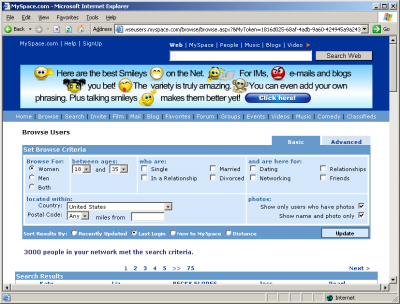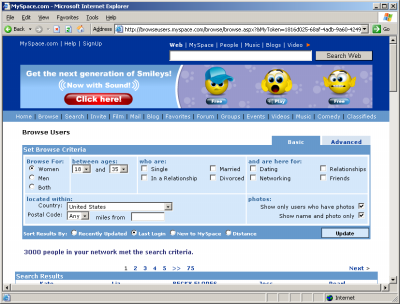

|
The Ad / Content Separation, and Ask.com Advertising at MySpace I present certain toolbar installation ads widely used by Ask.com on MySpace. I remark on the heightened risks that users may be confused about the origin and effect of the software offered. I consider relevant legal duties and governing principles. |
Related Projects Certifications and Site Trustworthiness The Safety of Internet Search Engines |
On major search engines, advertisements are generally prominently labeled as such. At Google, for example, a caption labels as ads "sponsored links," and their scope is delineated by a pastel background color. But it wasn't always this way. Initially, many search engines often failed to separate ads from their "organic" (ordinary) results. Only in 2002 did the FTC point out that failure to distinguish sponsored results from editorial content could be a deceptive practice -- yielding the FTC's instruction that search engines must do better.
Much like sponsored search results before 2002, banner ads generally aren't explicitly labeled as such. Fortunately, that failure to label is often blunted by the fact that ads' substance and design often directly distinguish them from other site content. But not always.
Ads at MySpace offer an intriguing case study. The format and substance of Ask.com's toolbar ads at MySpace tends to falsely suggest that these offers are part of MySpace. Some user confusion arises from the color, layout, and lack of a clearly-delineated separation between ads and content. Details. Crucially, the substance of Ask's offer also suggests an apparent affiliation with MySpace. Details. The net effect is users may install Ask toolbars under the false belief that these toolbars actually come from MySpace, or that they're in some way endorsed by MySpace.
Ask's toolbar ads -- "Zwinky," "SmileyCentral," screensavers, cursors, and more -- are remarkably widespread at MySpace. An AdRelevance report estimates that Ask toolbars were promoted via $2+ million on MySpace ads in July 2006 alone. In hands-on testing, I have often received Ask ads on 20% or more of MySpace impressions (e.g. three Ask ads within 15 MySpace page-views). But in one remarkable browsing session on October 16, I received an incredible 80%+ Ask ads (21 Ask ads within 26 page-views). Details and video proof.
The Duty to Distinguish Ads from Editorial Content
Footnote 4 of the FTC's 2002 search engine advertising letter cites prior FTC cases establishing the duty to distinguish editorial content from ads:
The Commission has brought actions against infomercial producers for failure to disclose that a television show was not an independent program but was, instead, a paid commercial advertisement. See, e.g., National Media Corp., 116 F.T.C. 549 (1993) (consent order). Similarly, the Commission alleged as deceptive the use of misleading formats that made an advertisement appear to be an independently written article published in a magazine. See, e.g., Georgetown Publishing House Limited Partnership, 122 F.T.C. 392 (1996) (consent order).
In both cited cases, the FTC considered both the substance and the format of an ad in finding a risk of users mistakenly concluding the offer came from an editorial (non-advertising) source.
I do not claim that Ask's ads rise to the level of deception required for FTC intervention. But I do think there's ample room for Ask and MySpace to improve. In that spirit, the remainder of this piece sets out the specific characteristics likely to cause users to conclude, erroneously, that these toolbars come from MySpace.
to topHow Ask's Ad Format Suggests that the Ask Toolbar Offers Come from MySpace
The format of Ask's ads tends to suggest that Ask's installation solicitations are an integral part of the MySpace site, rather than helping users understand that the Ask offers are advertising content from independent third party.
Consider the screenshots below. Ask's ads neatly match MySpace's color schemes (here, shades of blue). Ask's ads are not separated from the rest of MySpace by any explicit border (e.g. a solid line tracing the edge of the ad area). Nor does the word “advertisement” (or anything substantially similar) appear on or around the ads.
Furthermore, the Ask ads lack any branding or labeling indicating that they come from a third party rather than from MySpace itself. In particular, the ads lack any proper noun reporting their author, creator, beneficiary, or other responsible party.
 |
 |
These characteristics, in combination, make it plausible that these offers might come from MySpace itself. Of course some MySpace users will recognize the on-screen placement location as a region where MySpace generally shows ads. Other users may determine that the offers are ads using some other method. (Perhaps they've seen these same ads on other sites.) But on their face, these offers provide no specific reason to think they are ads from a third party independent of MySpace.
to topHow the Substance of Ask's Ad Suggests that Ask Toolbar Offers Come from MySpace
The substance of Ask's offers gives further reason why users may believe these offers come directly from MySpace, not from independent advertisers. The ads' substance fits within the substance of MySpace: Smileys appear likely to be useful in enlivening MySpace pages, as are Ask's “Zwinky” characters. Users might therefore reasonably believe that such offers come from MySpace itself, not from an independent third party.
Furthermore, language on the face of the first ad affirmatively suggests it could be part of MySpace. The ad says that these Smileys are "for ... blogs," and MySpace offers blog hosting. This subject overlap tends to suggest that the smileys are available for use within MySpace.


Some Ask ads even lead to landing pages that explicitly reference MySpace. See e.g. the landing page shown below, which prominently and boldly proclaims that its features are suitable to being "Add[ed] to MySpace."

Because the offered product is so closely related to the site on which it is promoted , users may reasonably conclude that the offer comes from MySpace -- mistakenly concluding that the offer is not an ad at all.
to topOther Ads Compared
Not all MySpace ads suffer these problem. Consider e.g. the YourGiftCards ad shown below. Notice that the ad uses colors quite different from MySpace (shades of pink rather than blue). Notice the inclusion of a proper noun ("YourGiftCards.com") serving both to indicate that a third party (not MySpace) is responsible for the ad, and to identify that party by name. I can't endorse YourGiftCards in general -- SiteAdvisor indicates that a single registration there can yield 147 emails per week. But their ad at least looks like an ad, rather than looking like an integrate part of MySpace.

to topTowards a Solution
In the short run, these practices could be addressed by Ask or MySpace suspending the offending ads.
More generally, Ask might revise the ads to reduce the likelihood of user confusion. One easy change would be to put a company name on each and every ad -- giving a prima facie indicator that the ad comes from a company other than the site a user is visiting. Where Ask advertises a product on a site with which the product has a special connection (e.g. MySpace), yielding a heightened risk of user confusion, additional affirmative disclosure and explanation may also be appropriate. For example, Ask's ads could be labeled with the standard text "advertisement," or even with the brief note "this offer comes from Ask.com, which is not affiliated with MySpace."
It's rare to see an ad on (for example) the New York Times web site that doesn't, on its face, indicate what company is being promoted. MySpace need not settle for a lesser standard. Every ad running on MySpace could be required to name the specific company or product being promoted, rather than leaving open the inference that the offer might come from MySpace itself.
Separately, some might question whether Ask ought to distribute its toolbar on MySpace at all, given the large number of users below age 18 on MySpace. Recall that Ask's toolbar purports to require special parental consent for such users. See separate discussion in my accompanying article, as to Ask advertising on sites targeting kids.
Last Updated: October 16, 2006 - Sign up for notification of major updates and related work.